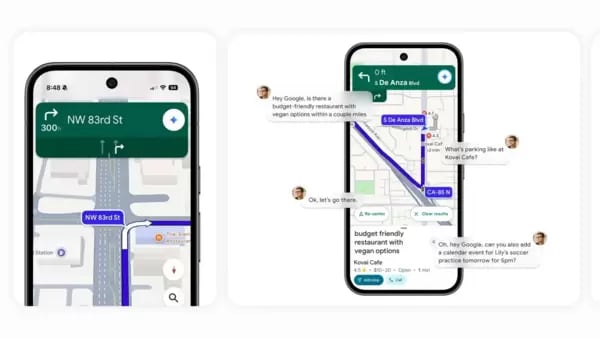Google Maps Integrates Gemini AI for Smarter Navigation
Google Maps is transforming into a conversational AI assistant with its latest Gemini-powered update, enabling hands-free route planning and real-world landmark navigation.
Key Takeaways
- Hands-free navigation with Gemini AI for finding places, checking EV chargers, and sharing ETAs
- Real-world landmark directions replacing distance-based instructions
- Proactive traffic alerts even without active navigation
- Visual search to identify and learn about nearby landmarks
Hands-Free Navigation with Gemini
Google is bringing conversational AI directly to Maps navigation. Users can now ask questions like “Is there a budget-friendly restaurant with vegan options along my route?” or “What’s parking like there?” without taking hands off the wheel.
The AI assistant can provide information about popular dishes at restaurants, check sports updates, and even connect with Google Calendar to add events automatically. This feature rolls out to all iOS and Android users in coming weeks, with Android Auto support coming soon.
Landmark-Based Navigation
Instead of vague “turn right after 500m” instructions, Maps will now use visible landmarks like gas stations, restaurants, and famous buildings. Instructions will change to “take a right after the Thai Restaurant” for easier real-world navigation.
Google achieves this by cross-referencing 250 million places with Street View images to identify the most useful landmarks. This feature launches for both Android and iOS users, but currently only in the US.
Proactive Traffic Alerts
Google Maps will now warn users about traffic disruptions even when not actively navigating. The app proactively notifies about unexpected road closures or heavy traffic to save time. This feature is initially available only for Android users in the US.
Visual Search with Gemini
Users can tap the camera in Maps’ search bar and point their phone at restaurants, cafes, or landmarks to get instant information. Similar to Gemini Live, this lets users ask questions like “What is this place and why is it popular?” or “What’s the vibe inside?”
This visual search feature rolls out to iOS and Android users in the US later this month, completing Google’s comprehensive AI upgrade to navigation.




